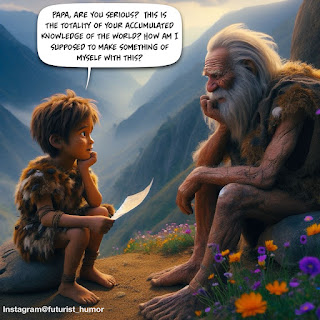Frank Diana, principal futurist at Tata Consultancy Services, argues foresight is the instruction manual for navigating the future’s chaos. Only his manual doesn’t give you a single design—it lays out multiple possibilities.
Kevin Benedict is a TCS futurist, humorist and lecturer focused on the signals and foresight that emerge as society, geopolitics, economies, science, technology, environment, and philosophy converge.
Practicing & Navigating the Future, #13
Frank Diana, principal futurist at Tata Consultancy Services, argues foresight is the instruction manual for navigating the future’s chaos. Only his manual doesn’t give you a single design—it lays out multiple possibilities.
A Bigger View of the Future, with Futurist Roger Spitz
The Recipe for an Unpleasant Future
 |
| Click to Enlarge |
To dismantle any hope for a prosperous future, we might begin by allowing inequality to grow unchecked. Wealth gaps could widen as access to essential resources, education, and healthcare remains limited to a privileged few. Resentment would fester, eroding social cohesion and creating an environment of mistrust. When opportunities are reserved for a select group, the collective spirit that drives progress is replaced by division and despair. Economic disparities, if left unaddressed, would sow the seeds of societal fracture.
The next step to ensuring failure would involve undermining truth and knowledge. By allowing misinformation to spread freely, the foundation of informed decision-making would crumble. Without shared facts and a respect for science, addressing global challenges like climate change, public health crises, and technological ethics would become nearly impossible. Imagine a world where biases and conspiracy theories drive policies—a world where truth is devalued and progress is perpetually out of reach.
Reaching 3 Million, Favorite Articles & Thank You!
The Great Collision: From Frontier Myths to Digital Dependence
The Future, Progress and Moral Frameworks
Those who believe in the inevitable progress of man, forget that the twentieth century was the bloodiest, most destructive century in human history. The century's two world wars alone resulted in the deaths of at least 60 million people.
Reading the News Like a Futurist with Alex Whittington
Using Physics to Understand the Future
"While there can be surprise technological and market disruptions, classical Newtonian mechanical physics’ suggestions that trajectories are the flight paths determined by mass positioning, direction, and momentum as a function of time can help us make accurate predictions." ~ Jeffrey A. Sonnenfeld & Steven Tian
As a writer, I appreciate gifts of inspiration. Reading the above quote set my mind off this morning. It is so true! As a futurist we are always studying trends, innovations and developments, and then searching for signals that will inform us about the "trajectories," each of them will follow. Using Newtonian mechanical physics as helpful metaphors to understand directions and how much inertia a trend has, how fast it is changing, and how much resistance it might face are all useful considerations.
I have had the pleasure over the last year to meet with the leadership teams of many large companies around the world to talk about the future. Bringing a list of over 350 fast evolving trends across the domains of science, technology, societal, geopolitical and economic is a good place to start, but these discussions almost always turn quickly toward Newtonian mechanical physics. How much? How fast? When? What direction? How much inertia? What kind of resistance? These are the right questions!
As I covered in an article earlier this week, we can create different buckets of trends, innovations and developments. Some, are incremental innovations, while others are "launchpad" developments that will support entire new ways of thinking and will change the direction of our future.
It's not enough to pocket a list of quickly evolving trends, developments and technologies. One must understand the physics involved, the dependencies for a development to move forward, understand which rung on the historic ladder of progress a development is sitting, and also understand it's potential for scaling. These, of course, are just the beginning, but they are a good place to start.
A Futurist Pondering Biological vs. Digital Learning
Lessons in Scaling
- Technological Innovation: At the core of most scaling endeavors is a technological breakthrough. From the invention of the plow in agriculture to cloud computing in the digital age, technology acts as a catalyst that enables scaling by improving efficiency and productivity.
- Standardization: The adoption of the alphabet and the creation of global supply chains both required standardization (think 40 foot shipping containers). Standardized processes, measurements, and systems enable replication and consistency, which are essential for scaling.
- Infrastructure Development: Robust infrastructure, such as Roman aqueducts and sewage systems, railroads, and telecommunication networks, supports the expansion of scale by facilitating the flow of goods, services, and information.
- Economic Systems: The development of financial institutions and corporate structures provided the framework necessary for scaling industries and managing large-scale economic activities efficiently.
- Sociopolitical Factors: The spread of major world religions and the impact of world wars demonstrate the role of governance, ideology, and organizational capability in scaling. These factors can direct resources, mobilize populations, and enforce systems that enable scaling.
- Globalization: Many forms of scaling were made possible due to the expansion of global interactions. Trade routes, maritime technologies, and later, aviation and the internet, all contributed to creating a globalized world where ideas, products, and innovations could scale rapidly.
- Human Capital Development: The proliferation of global education systems and the resultant improved literacy rates fostered a knowledgeable workforce capable of driving and sustaining scaling efforts.
- Regulatory Frameworks: As seen with the United Nations' formation, effective scaling often requires governance structures that can manage increased complexity and maintain standards across expanded domains.
- Ethical and Social Considerations: The negative aspects of scaling, such as labor conditions during the Industrial Revolution or the environmental impact of the oil industry, highlight that scaling often brings with it ethical and societal challenges that need addressing. Synthetic biology, artificial intelligence and climate change ensure these kinds of ethical challenges will continue into the future.
 |
| Scaling has Benefits |
The Legacy and Future of Scaling
A Kaleidoscopic Future
Influencing the Future or Not
The Best Future Focused Interviews of 2022
- What Do You Believe about the Future with Futurist Gerd Leonhard
- How Humans Learned to See the Future with Futurist Byron Reese
- The Past, Present and Future of the Digital Workplace with Expert Ashok Krish
- 2020 Revisited with Cornell Tech’s Greg Morrisett
- The Future of Income, Careers and Human Potential with Alex Whittington
- Winning the Right Game - Ecosystem Business Strategies with Dr. Ron Adner
- The Future of Climate Risk with Expert Steve Bennett
- The Future of Safety with Expert Christoffer Malm
- Understanding the Future and How to Prepare with David Espindola
- The Future of Eldercare with Expert Ved Sen
Preparing for the Future: Operating in Three Time Dimensions
The better we are at understanding the future, the more value can be harvested from it today. ~Kevin Benedict
What You Believe about the Future with Futurist Gerd Leonhard
The Future of Income, Careers, and Human Potential with Futurist Alex Whittington
The Cultural Trait that Changed the World
Time Passes On a One-Way Street
Presentist vs. Futurist
Interviews with Kevin Benedict
-
Speed, Complexity, and Strategic Foresight We are living through a historic moment where velocity, convergence, and disruption accurately de...
-
This article is a comprehensive exploration of Finland’s extraordinary achievement in becoming the world's happiest country, not once, b...
-
In this engaging FOBTV episode, I have the opportunity to interview Zvi Feuer, CEO Siemens Industry Software Israel, about the transformativ...


















